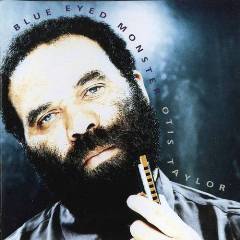Otis Taylor - Blue Eyed Monster (1997)
Otis Taylor - Blue Eyed Monster (1997)

1 Black Betty 0:40 2 Harry, Turn The Music Up 3:10 3 Hungry For Love 6:05 4 Nobody Knows My Name 5:40 5 Sito's Banjo Rag 0:28 6 Odie's Train Time 4:05 7 Coffee Woman 4:04 8 Sito's Banjo Rag 0:25 9 Ham Bones 1:30 10 Hey Joe 7:27 11 Sleepwalking Monster 4:45 12 Crawlin' King Snake 6:13 13 Laughing At The Moonlight 2:20
Otis Taylor is one of the most intriguing and interesting of contemporary blues artists. Unlike many bluesmen who start young and grow into the music, Taylor's nearly 20-year absence from the industry meant that he returned with an experienced, mature perspective unlike anything in the blues. Although Taylor's sound is a unique hybrid of Delta-inspired country-blues and traditional folk and mountain music, his intelligent and insightful lyrics display a contemporary edge, tackling such prickly subjects as race relations, poverty, drug abuse, and social injustice.
Taylor was born in Chicago, but his family moved to Denver, Colorado after the death of his uncle while he was still quite young. The shooting of his uncle would prove to be an important moment in Taylor's life, and he would write about it on his 2001 album White African. Taylor's first instrument was the banjo, which he would later set aside for harp and guitar after learning of the banjo's minstrel show history.
The young musician began hanging around the Denver Folklore Center, where Taylor would be exposed to the music of Mississippi John Hurt and country blues. By his mid-teens he would form his first bands - the Butterscotch Fire Department Blues Band and the Otis Taylor Blues Band. Taylor was also influenced by artists like Etta James, Muddy Waters, and Junior Wells, and he would begin dallying in folk and Appalachian music.
In 1969 Taylor moved to England to pursue a record contract with Blue Horizon, returning to the states after the deal failed to go through. Back in Denver, Taylor formed the T&O Short Line with noted guitarist and (future) James Gang/Deep Purple member Tommy Bolin. Adding mandolin to his multi-instrumental toolkit, Taylor would later perform with the Denver-area band Zephyr before temporarily retiring from the music business in 1977.
Taylor spent the decade of the 1980s and much of the '90s as an antiques dealer and as the coach of an amateur bicycling team. At the urging of his friend, session bassist Kenny Passarelli (also a veteran of Joe Walsh's band), Taylor returned to music in 1995. Two years later, he would release his first solo album, Blue Eyed Monster, a collection of uncompromising blues songs. He would follow his debut with 1988's critically-acclaimed When Negroes Walked The Earth.
In the summer of 2000, Taylor received a composition fellowship from the Sundance Institute in Park City, UT and he later attended the Sundance Film Festival. White African, released in 2001, would be Taylor's first album to receive national distribution, and would be nominated for four Blues Music Awards, winning for "Best New Artist Debut." The album's treatment of the brutality experienced by African-Americans, including the lynching of his great-grandfather and the death of his uncle, would provide a contemporary edge to a classic folk-blues sound.
During the 2000s, Taylor has released a slew of well-received albums, roughly one every year, collections like Respect The Dead; Truth Is Not Fiction, with which Taylor introduced the concept of "trance blues;" and Double V all building upon the artist's unique blues music vision and earning Taylor a number of critical accolades and expanding his audience.
Taylor's talented daughter Cassie has also taken up the "family business," contributing vocals, guitar, and bass to her father's recordings. Taylor is also involved with "Blues In The Schools," visiting schools and colleges and presenting the "Writing The Blues" program he created with his wife Carol, mentoring students on blues music.
In 2008, Taylor took it upon himself to restore the banjo's place as a treasured musical instrument of West African origin, recording Recapturing The Banjo with fellow multi-instrumental bluesmen Guy Davis, Corey Harris, Alvin Youngblood Hart, Don Vappie, and Keb' Mo'. --- blues.about.com
download (mp3 @192 kbs):
uploaded yandex 4shared mediafire mega solidfiles zalivalka cloudmailru filecloudio obom uplea








